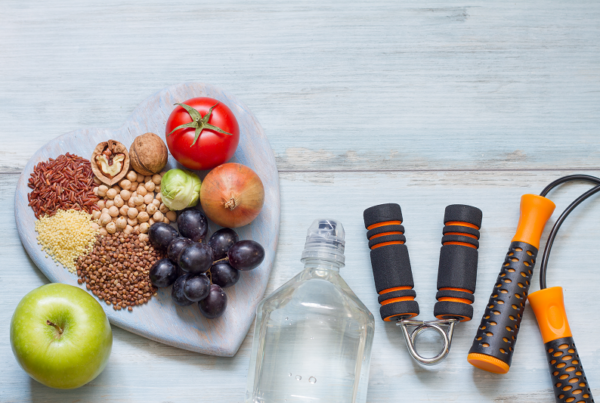
I’m middle-aged. I cannot believe I’m actually saying those words but I just have to accept it (mmm…but I really do feel 30…maybe I’ll go with that one). I have friends and loved ones who have never struggled with their weight before suddenly now realising where the dreaded ‘muffin-top’ name comes from; or discovering love-handles for the first time. For others, it just means adding even more pounds to a shape they were never happy with.
You’ve heard the reasons before…’It’s because your metabolism slows down as you age’ or ‘You need to eat less as you get older or you’ll put on weight’. It’s explained in terms that make it sound inevitable, as if it’s a foregone conclusion…BUT I’m here to tell YOU THAT’S ACTUALLY WRONG!
Flex those Muscles to Burn More
There’s a really simple explanation…and it’s about muscle. Sarcopenia is the term used to describe the muscle loss that starts around age 30-40, when most of us begin to lose about half a pound of muscle each year. At age 50, that rate doubles. In fact, towards the end of the 50s, experts suggest that a woman could lose about as much as one stone of muscle; a change that could lead her to gain about the same amount of fat…so, essentially, she might be happy enough with what the scales says, but she will be flabbier and weaker than ever before (yet another reason people that the scales are misleading).
Muscle is what is known as ‘metabolically active’ – it’s a ‘fat shredder’. In other words, muscle is a serious fat burner (which also explains why men tend to lose weight more easily or quicker than women, as they have a higher muscle content in their body). With more muscle in your body – even just a few pounds – you can burn about 100-200 more calories each day; even when you’re sleeping! And a few pounds is really not that hard to build. The opposite movement – when you lose muscle – means things slow down and you need less calories than you did before. Now that one’s easy – it happens when we become more sedentary.
So, in other words, to be able to get away with eating the same amount of food, you need to up your muscle-gaining exercise. That doesn’t necessarily mean pounding it out in the gym (although if you like a regular gym fix, I’m all for it); it could also means things such as taking up a pilates or yoga class, or looking into aqua-aerobics, or simply just doing a few weights or floor exercises at home (push-ups, squats and lunges are all great for building muscle). For anyone over 40, I highly recommend a personal training session – you can see great results in muscle gain/fat loss with even just one session each week (on top of your usual walks etc…). It’s well worth the investment.
No Need for a Six-Pack (Although it Would be Nice!)
And, before you ask, no it’s not necessary to become a body builder. Nor is it necessary to work out every single day. The experts agree that specific strength training just once or twice a week, on top of your usual walk or jog roughly three times a week, is enough to make a difference. The benefits of enjoying a metabolism boost will mean weight loss – and maintenance – becomes so much easier. And the added benefit is firming up of those bat-wings, developing more shapely thighs or a ‘higher’, perkier bum…it’s enough to make anyone squat 100 on the spot!
Of course, you know we can’t talk about metabolism without mentioning our friend protein. Experts now know that, combined with exercise, eating regular protein (yes, that’s right – every 3-4 hours) is essential for building muscle. How does it work, you ask?
Well, each time you eat a protein-rich food, such as an egg – your body gets to work, breaking it down into amino amino acids. These enter your bloodstream and are absorbed by your muscle tissues and other cells. According to Douglas Paddon-Jones, Director of Exercise Studies at University of Texas, “Once the amino acids end up in your muscles, your body starts putting them back together – sort of like Lego – into your muscle tissue. This is called muscle-protein synthesis; it’s the process your body uses to build and maintain muscle mass.
Little and Often
Muscle-protein synthesis goes up after you eat a protein-rich meal, and it goes down a few hours after (when your body basically canibalises the muscle and breaks it down). Usually the ups and downs are in balance, but if you eat too little protein, your metabolism will decrease (and the same effect occurs with too little exercise). For inspiration to pack some more protein in, take a look at some of our recipes such as this turkey chilli.
And the secret to get your protein intake ‘just right’? It’s to eat it often. As well as eating protein at each sitting (eg. eggs, fish, beans, lentils, chicken, meat etc…), it’s key to get in those mid-morning and mid-afternoon snacks (a protein bar, drink or protein crisps), and perhaps also a post-dinner snack. Interestingly enough, there are a few other factors that help to preserve muscle, which are also things recommended on your weight loss programme with Motivation. Read more detail here.
Those things include taking a daily high dose of omega-3 and also reducing your alcohol intake, which is known to contribute to muscle wasting. So keep following your programme and you’ll give yourself the best chance of, not only a more toned appearance, but also a more efficient metabolism needed to keep you lean well into your 50s, 60s and beyond. This is the real secret to managing weight.



